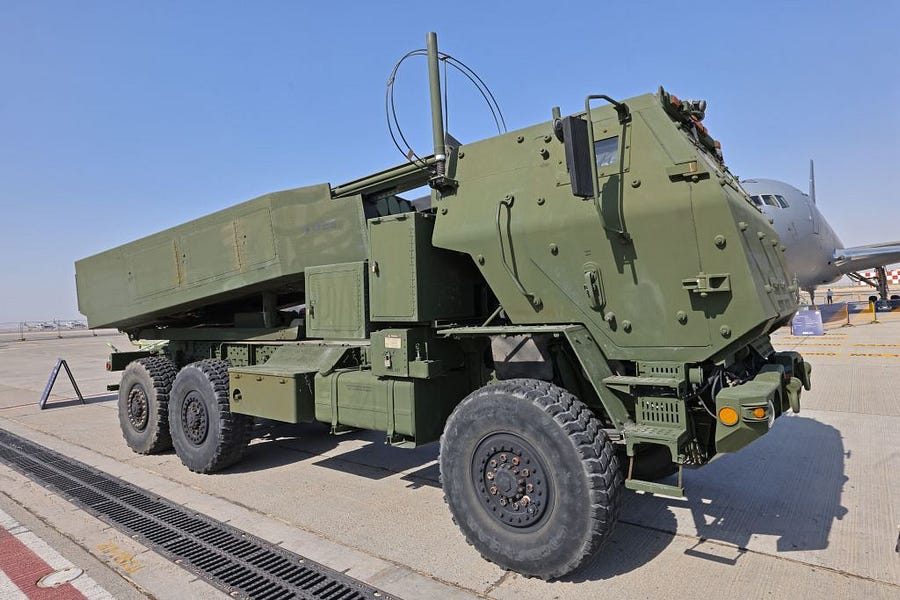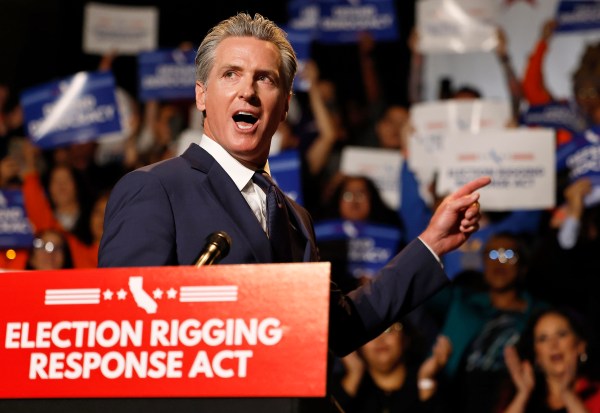Newsflash: Joe Biden has loose lips.
We’ve known this for decades, but now the “sinking ships” part of the equation looms, both in East Asia—where Biden for the third time has explicitly declared the United States would defend Taiwan in the event of a Chinese attack—and in Eastern Europe, where Biden repeatedly blurts out what he will not do to defend Ukraine and the larger post-Soviet peace from Russian attack. The Deputy National Security Adviser for Walking Things Back has been busy lately.
At least Biden’s most recent gaffe—“We are not going to send to Ukraine rocket systems that can strike into Russia!”—got walked back within 24 hours, and by the president himself. The upcoming $700 million package of military aid to Kyiv, which will draw from the $40 billion in aid voted on by Congress and signed by Biden, will include many things, but among them will be a “small number of high-tech, medium-range rocket systems,” most probably the U.S. Army’s M142 High Mobility Artillery Rockets System, or HIMARS.
To understand how Biden has split the baby—and what he probably meant to say originally—a brief artillery tutorial is needed. The HIMARS is a wheeled, half-sized version of the larger tracked M270 Multiple Launch Rocket System, yet another legacy of the Reagan defense investments of the 1980s. The MLRS was developed specifically to offset Soviet advantages in artillery; it was mounted on a tracked vehicle to keep up with the speedy armored formations built around the M1 tank and Bradley Fighting Vehicle and to be able to work in tandem with Army aviation. The HIMARs version came along in the 1990s to supplement the capabilities of airborne and light infantry units.
Both the tracked MLRS and wheeled HIMARS systems are capable of firing a family of rounds with different warheads (some with GPS guidance systems) and varying ranges—from 20 miles in the case of the original MLRS rocket to 170 miles or more in the case of the Army Tactical Missile System. Following the president’s “clarification”—which came in the form of a New York Times opinion column—the Pentagon suggested that the Ukrainians would receive the M30 rocket, the most common round of both HIMARS and MLRS, with a range of about 40 miles, and can be precisely guided.
Make no mistake: This rocket can hit Russia. Indeed, from the Ukrainian border, it can hit Belgorod, a major Russian depot and communications node—a very inviting target from a Ukrainian point of view. More critically, a sufficient supply (there are about 500 HIMARS launchers in the world, mostly in the U.S. Army but also among the Marine Corps, Gulf Arab states, and other allies) and plenty of ammunition would further turn the balance of artillery power in the Ukraine conflict. It would also build upon a Ukrainian qualitative advantage; the Ukrainian artillery corps has developed a networked and distributed approach to calling for fires. Think of it as a ride-sharing app that links “customers”—Russian targets—with the nearest “driver”—a cannon, a rocket system, a mortar, whatever—to permit both rapid attack and improved survivability. The artillerist’s mantra of “shoot and scoot” has been the key to Ukraine’s ability to hold its own against massive Russian barrages.
Finally, the smaller, lighter HIMARS launcher may best suit the Ukrainian artillery modus operandi—though reports coming out of London indicate that the British government has requested U.S. permission to transfer some of its tracked MLRS systems to Ukraine as well. But the HIMARS is preferable in part because it rides on a basic truck chassis that is ubiquitous and much easier to service. Indeed, no lesser authority than Markos Moulitsas—he of Daily Kos renown—admitted via Twitter that he was an MLRS crewman once upon a time and that “keeping our [tracked MLRS vehicles] up and running was a nightmare.” Of equal importance: Tracked vehicles leave tell-tale track marks on softer surfaces, easily visible to reconnaissance drones and thus prone to revealing vehicles, fuel points, and assembly areas. Finally, the HIMARS launcher can be transported in the smallest of U.S. cargo aircraft, the C-130, and thus can be shipped to Europe more easily and can be driven into Ukraine by itself, not requiring a heavy tractor trailer or railcar.
But there were more important passages in the Biden essay than the artillery announcement. Even as he reiterated what he would not do in Ukraine, he at last gave a strong and summary statement of what he would do. He recognized that the fundamental decisions about the war would come from Kyiv: “Nothing about Ukraine without Ukraine.” This was a timely reminder to the squeamish in Germany, France, Italy, and across Western Europe, to the stout in Poland, the Baltic, and other Northern, Eastern and Central European countries, to the reprobates in places like Hungary and Serbia who are betting on Putin.
This was also a shot across the bow of both outright Russophiles and “realists” domestically. The latter, until lately hushed by the Russian repulse at the gates of Kyiv and Kharkiv, have enjoyed something of a rehabilitation as the fight in the Donbas becomes a grinding battle of attrition; they have seen the inching advance of Russian forces around Severodonetsk as the inevitable expression of Russian material superiority. A week ago Henry Kissinger, the 98-year-old oracle of American realism, told the World Economic Forum at Davos that Ukraine should sign a land-for-peace deal with Putin, unleashing a torrent of punditry, even from the New York Times editorial board.
However, as is so often the case, the geopolitical sphere-of-influence crowd often lacks a sense of the technological, tactical, and operational flows of war—as well as the importance of moral versus material power. And Western analysts have had a hard time grasping the logic of Ukrainian strategy. At the moment, the obsession with an epic “Battle of the Donbas” obscures what’s going on elsewhere. To begin with, desperate for something he can spin as a victory, Putin and his commanders are throwing whatever forces they can scrape up into encircling Severodonetsk. In this, they are paying an excessive price for a smaller prize, one they are also laying waste to. Ukrainian reports, which have usually been quite accurate assessments, indicate that some Russian battalion tactical groups—the basic Russian army maneuver unit—have lost more than half their manpower and an even greater percentage of their equipment. The “caution” and slow pace of Russian advance is one part lesson learned from previous mistakes but another, and perhaps greater, part diminished capacity.
As the Russians gathered their strength for the Donbas, the Ukrainians made other choices. First of all, they made sure that the Russians were pushed beyond tube-artillery range of Kyiv and then Kharkiv. They have made exploratory thrusts that threaten Russian rail supply lines—the real key to Russian army logistics—in the Donbas. But in the last week they have begun to mount larger counterattacks in the south, aimed at Kherson. This is not only a critical Black Sea port but a key to the Russian “land bridge” running from Crimea to the southern Donbas and Russia proper. The Russians are doing their best to create more fortified defenses around Kherson, but it is not clear they have the resources to do so; Ukrainian forces have advanced along the Dnipro River, and appear to have positions on the east side.
In sum, as Margaret Thatcher famously (if perhaps apocryphally) lectured President George H.W. Bush, “now is not the time to go wobbly” in Ukraine. President Biden would do well to reflect on the fact that American commanders in chief enjoy enormous latitude, both internationally and domestically, in the conduct of war; when President Bush 43 set his mind to “surge” combat forces in Iraq, the Democrat-controlled Congress (including Speaker Nancy Pelosi) whined a lot but gave him every penny he requested.
In the case of Ukraine, Biden has a powerful argument to make. “Unprovoked aggression, the bombing of maternity hospitals and centers of culture and the forced displacement of millions of people make the war in Ukraine a profound moral issue,” the president wrote. But “standing by Ukraine in its hour of need is not just the right thing to do.”
It is in our vital national interests to ensure a peaceful and stable Europe and to make it clear that might does not make right. If Russia does not pay a heavy price for its actions, it will send another message to other would be aggressors that they too can seize territory and subjugate other countries. It will put the survival of other peaceful democracies at risk. And it could mark the end of the rules-based international order and open the door to aggression elsewhere, with catastrophic consequences the world over.
This is realism of a common-sense sort, a simpler and surer assessment of the Hobbesian world hovering behind the curtain at Davos. Repeating it could even transform Biden’s loose lips into a powerful weapon.
Giselle Donnelly is a senior fellow in foreign and defense policy studies at the American Enterprise Institute.






Please note that we at The Dispatch hold ourselves, our work, and our commenters to a higher standard than other places on the internet. We welcome comments that foster genuine debate or discussion—including comments critical of us or our work—but responses that include ad hominem attacks on fellow Dispatch members or are intended to stoke fear and anger may be moderated.
With your membership, you only have the ability to comment on The Morning Dispatch articles. Consider upgrading to join the conversation everywhere.